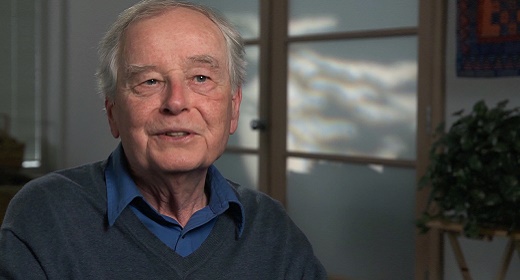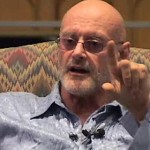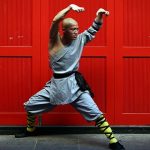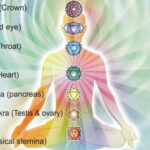by Daisetz Teitaro Suzuki: Those of you who are accustomed to listening to the usual explanations of Pure Land Buddhism may find my lectures on this subject unusual and unorthodox, but I am willing to take that criticism.

Ordinarily speaking, Pure Land doctrine
is heavily laden with all kinds of what I call “accretions,” which are not altogether necessary in order for modern people to get at the gist of the teaching.
For instance, Amida is the principal subject of Pure Land Buddhism. He
is represented as being so many feet in height and endowed with the excellent
physical features of a great man; he emits beams of light from his body, illuminating the world—not just one world, but many worlds, defying human calculation or measurement; and on every ray of light that comes out of his body, in fact, from every pore of his skin, there are so many Buddha-lands, decorated in a most extravagant manner. The descriptions almost exceed the imagination.
Of course this too is the product of man’s mind, so I cannot really say it is
beyond human imagination. But we can see how the Indian mind, more than any
other, is richly endowed with the ability to create imagery. When you read the
sūtras and listen to the old ways of explaining Pure Land doctrine, you will be
surprised at how differently those people viewed such things, when compared
with our modern way of thinking.
I am not going to touch upon these traditional aspects of the doctrine, so I
am afraid my own explanations will be somewhat prosaic, devoid of the usual
glamour and rich imagery. In a way, it will be Amida religion brought down to
earth; but at the same time the doctrine is not to be treated from the intellectual
point of view, on the relative plane of thought. It is after all altogether beyond
human intellection.
The Pure Land and Amida are revealed on this earth, though not as is taught
by orthodox preachers. The Pure Land is not many millions and millions of
miles away to the west. According to my explanation, the Pure Land is right
here. Those who have eyes to see it can see it right here, even in this very hall.
Amida is not presiding over a Pure Land beyond our reach. His Pure Land is this
dirty earth itself. When I explain things in this way I am going directly against
the traditional or conventional Pure Land doctrine. However, I have my own
explanations and interpretations, and perhaps after these lectures are over you
will agree with them, though of that I cannot be quite sure!
A Japanese Shin Buddhist friend of mine in Brazil recently wrote to me,
requesting that I write out the essential teachings of the Pure Land school in
English for the Buddhists there, because they found it difficult to translate such
things from Japanese into Portuguese. He wanted me to present it so as to make
Amida and Pure Land doctrine appear somewhat similar to Christianity, at least
superficially, and yet to retain characteristic features of the Pure Land doctrine.
So I sent the following to him. Whether he agreed with my views or not, I do not
know. You might say I wrote it for my own edification.
First: We believe in Amida Butsu, Amitabha Buddha, as Savior of all beings.
(“Savior” is not a word often used among Buddhists; it is a kind of condescen
sion to the Christian way of thinking.) This Amida Buddha is eternal life and in
finite light. And all beings are born in sin and laden with sin. (This idea of sin is
to be specially interpreted to give it a Buddhist color, which I will do later on.)
Second: We believe in Amida Buddha as our Oya-sama. (Sometimes the
more familiar “Oya-san” is used in place of “Oya-sama,” but the latter is more
generally used. Oya-sama, in this context, means love or compassion. Strictly
speaking, there is no word corresponding to Oya-sama in English or any Euro
pean languages. Oya means parent, and -sama is an honorifi c suffix. Oya can
mean either father or mother, and can also mean both of them; not separately,
but mother and father as one. Motherly qualities and fatherly qualities are united
in Oya. In Christianity God is addressed as Father: “Our father which art in
Heaven.” But Oya-sama is not in heaven, nor is Oya-sama the Father. Oya-sama
is neither a “he” nor a “she.” I don’t like to say “it,” so I am at a loss what to say.
Oya-sama is such a peculiar word, so endearing and at the same time so full of
religious significance.)
Third: We believe that salvation (“salvation” is not a good word here, but I
am trying to comply with my friend’s request) consists in pronouncing the name
of Amida in sincerity and with devotion. (This pronouncing the name of Amida
may not be considered so important, but names have certain magical powers.
When a name is uttered, the object bearing that name is conjured up.)
In The Arabian Nights’ Entertainments, when the devil’s name is pro
nounced, the devil appears. Among some primitive peoples, the name of the su
preme being is kept a secret. It is revealed only to those who have gone through
certain rituals. The initiate is led by one of the elders of the religion into a dense
forest where there is no danger of being overheard by anybody. Then the elder
reveals the name to him. By knowing the name, the initiate is now fully qualified
as a leader himself. The name plays an important role in religious life.
Amida’s name is pronounced in sincerity and with devotion. The formula is
Namu-amida-butsu. Butsu is Buddha, namu means “I take refuge”: I take refuge
in Amida Buddha. Or we may take namu as meaning adoration to Amida Bud
dha. It is a simple formula. There is nothing especially mysterious about it, and
you may wonder how this name or phrase could have such wonderful power.
Now I have to say something about hongan. Hongan, according to my inter
pretation, is the primal will. This primal will is at the foundation of all reality.
Hongan as expressed in the Sūtra of Eternal Life consists of 48 different vows,
but all 48 may be summarized in one basic vow, or hongan, which is: Amida
wants to save all beings. Amida desires to have all beings brought over to his
land, which is the land of purity and bliss. And those who earnestly, sincerely,
and devotedly believe in Amida, will all be born in the Pure Land.
This birth does not take place after what is called death. To sincere followers
of the Pure Land, instead of being born in the Pure Land, the Pure Land itself
is created or comes into existence when we sincerely pronounce Namu-amida
butsu. Therefore, instead of going over to the Pure Land, the Pure Land comes
to us. In a way, we are carrying the Pure Land within us all along, and when we
pronounce that magic formula Namu-amida-butsu, we become conscious of the
presence of the Pure Land around us, or rather, in us.
The hon of hongan means original or primal, and gan is generally trans
lated “vow.” But I have misgivings about using vow as an equivalent for gan.
Sometimes it is translated “prayer.” Gan means literally “wish” or “desire.”
Philosophically speaking, it may be better to say “will,” so that hongan would
be rendered “primal will.” Why gan cannot properly be translated as “vow,”
“prayer,” “wish,” or “desire” will become clearer later. I am just trying to give
you an idea now of how I interpret some of these terms.
I wrote a little book called A Miscellany on the Shin Teaching of Buddhism
which was published in Japan in 1949. It contains rather fragmentary explana
tions of the Shin teaching, but parts of it may be helpful in gaining a general
view of Shin Pure Land Buddhism.
The Pure Land teaching originated in China, but it reached its full develop
ment in the Japanese Shin school of Pure Land Buddhism. The Shin school is the
culmination of Pure Land thought, and that culmination took place in Japan. The
Japanese may not have very many original ideas to contribute to world thought
or world culture, but in Shin we find one major contribution Japanese can make
to the outside world. There is one other major Buddhist school that developed in
Japan, the Nichiren sect. But all the other schools more or less trace their origin
as well as their form either to China or to India. Nichiren is more or less related
to the nationalistic spirit of Japan and is often confused with nationalism. But
Shin is absolutely free of such connections; in that respect, Shin is remarkable.
Shinran, the founder of the Shin sect, was born in Kyoto about eight hundred
years ago. He is generally made out to be of noble lineage, but that I suspect is
fiction. His family was probably relatively cultured and may well have belonged
to the higher levels of society, but their connection, if any, to the aristocracy
was I think remote. In any case, his real religious development took place when
he was exiled to the country, far from the capital, the center of culture in those
days. He was a follower of Hōnen, founder of the Pure Land (Jōdo) school in
Japan. Hōnen’s influence was very great at the time, and priests belonging to
the older established schools did not like that. Somehow they contrived to have
Hōnen banished to Tosa, then a remote area of the country. Shinran was also
exiled, to the northern part of Japan. His decisive religious experience really
took place during this exile, while he was living among the common people. He
understood well their spiritual needs. In those days Buddhism was somewhat
aristocratic, and the study of Buddhism was mainly confined to the learned few,
who were rather addicted to learning. But Shinran knew that mere learning was
not the way to religious experience. There had to be a more direct way that did
not require the medium of learning or ritual. In fact, to experience a full awak
ening of the religious consciousness, all such things must first be cast aside.
Such mediums would only interfere with our attempts to directly attain this full
awakening, which is the consummation of the religious life. Shinran came to
realize this himself, and he finally found the most direct way to the attainment
of this awakening.
Let me read a bit now from A Miscellany on the Shin Teaching:
Of all the developments Mahayana Buddhism has achieved in the Far East, the
most remarkable one is the Shin teaching of the Pure Land school. It is remarkable,
according to my judgment, chiefly for the reason that geographically its birthplace
is Japan and historically it is the latest and highest evolution the Pure Land teaching
could have reached. The Pure Land idea originated in India (because the sūtras used
by this sect were originally compiled in India, the ideas must have developed fi rst in
India) and the sūtras devoted to its exposition were compiled probably about three
hundred years after Buddha (that is, about one or two centuries before the Christian
era). The school bearing its name, however, started in China towards the end of the
fifth century when the White Lotus Society was organized by Hui-yüan (334-416) and
his friends in 403. The idea of a Buddha-land which is presided over by a Buddha is
probably as old as Buddhism, but a school based upon the desire to be born in such a
land in order to attain the final end of the Buddhist life, did not fully materialize until
Buddhism began to flourish in China as a practical religion. It took the Japanese genius
of the thirteenth century to mature it further into the teaching of the Shin school. Some
may wonder how the Mahayana could have expanded into the doctrine of Pure Land
faith, which apparently stands in direct contradiction to the Buddha’s supposedly
original teaching of self-reliance and enlightenment by means of prajñā.
[Dr. Suzuki explains the following Shin terms at the blackboard]
Amida is standing on one side, and on the other side is bombu (or bompu), the
ordinary people, just as we all are. We sometimes see this term rendered as “all
beings” in English. Amida Buddha is the hō (Dharma), and we bombu are ki.
Hō and ki are difficult terms to translate. Hō is on the other side and ki is on this
side. Religious teachings start from the relationship between them. Hō might be
considered as corresponding to God or Christ, and ki is this sinful person. Hō
is the o
ther-power, and ki is self-power. Other-power and self-power stand in
contrast; and in order to be born in the Pure Land, self-power is to be altogether
abandoned and other-power embraced. In fact, when self-power is embraced
by other-power, self-power turns into other-power; or, other-power “takes up”
self-power altogether.
Or again, on one side we have the Pure Land, and on the other side this world.
“This world” is more commonly called shaba in Japanese and Chinese—it is a
Sanskrit term originally. The other world is called Jōdo. (Jō means pure, do is
land, or “Pure Land.”) Shaba is, we might say, the land of defilement. So there is
Jōdo, the land of purity, or the Pure Land, and shaba, the defiled land. The Pure
Land is the realm of the absolute, and shaba the realm of relativity.
When we pronounce Namu-amida-butsu, Amida is on one side and namu is
on the other. Namu represents self-power or ki; Amida is hō, the other-power.
Namu-amida-butsu symbolizes the unifi cation of ki and hō, Amida and bompu,
self-power and other-power, shaba and Pure Land—they are unifi ed, identified.
So when Namu-amida-butsu is pronounced, it represents or symbolizes the uni
fication of the two. “Unification” is not an adequate term, but its meaning will
hopefully become clearer.
Now Amida is on the other side, the bompu is on this side, and shaba is
where we are. The Pure Land reveals itself when we realize what we are, or,
what Amida is. Other-power is very much emphasized in Shin teaching. When
Amida and other-power are understood, the Pure Land will be understood too.
When Amida’s essential quality is understood, hongan and compassion, or love,
also become known. It is just like holding a cloth at the central part; if you pull
the middle up, all the rest comes with it.
In giving names to objects we commonly fall into the error of thinking that the
names stand for the actual objects themselves. This is a danger that is always
present in name-giving, but we cannot on that account disregard the importance
of names. Names represent a form of discrimination; they help us distinguish
one thing from another, and this enables us to know their nature to some extent.
Without a name, an object could not be distinguished from other objects. Distin
guishing or discriminating helps us in this way to understand the objects around
us. But names are not everything.
Man is also distinguished from other beings in that he is a toolmaker. Names
are also a sort of tool; we can put them to use to better deal with the objects
around us. But there is also a tyranny of tools. We make and surround ourselves
with tools of all kinds, whereupon the tools begin to tyrannize us. Instead of us
using them, they turn against their inventor. We become the tools of the tools
we make.
This situation is especially noticeable in modern life. We invent machines,
and they in turn control human affairs. Machines, especially in recent years,
have inextricably entered our lives. We now must try to adjust ourselves to ma
chines, for once they are out of our hands they refuse to obey our will.
In our intellectual endeavors, our ideas can be despotic too. We cannot al
ways be in control of ideas. We invent or construct ideas and concepts to make
life more convenient. Then these very ideas which we intended to be so con
venient become unmanageable and control the inventors themselves. Scholars
invent ideas and then forget that they invented them in order to deal with certain
realities. For instance, each of the branches of science, whether it is called biol
ogy, psychology, or astronomy, has its own premises, its own hypotheses. Each
branch organizes the fields it has chosen—stars, animals, fish, and so on—and
deals with those realities according to the special concepts its scientists have
invented to enable them to handle the subjects of their research. Whatever situ
ation comes along in the pursuit of their research or exercise of their ideas that
does not happen to be amenable to those ideas, they drop. Instead of dropping
the ideas and trying to create new ones in order to overcome the unexpected dif
ficulties that arise, they stick to the old ideas they invented and try to make the
new realities fit the old concepts. Or else they simply exclude those things which
cannot easily be worked into the network of ideas they have invented.
I have heard that some scientists have themselves compared their methods
to catching fish in a net with standardized meshes; those fish which fail to be
scooped up in the net will be dropped and unaccounted for. They just take up
those that can be caught in their net and try to explain their catch by means of
their ready-made ideas. The fish that remain uncaught are treated as if they did
not even exist. “These exist,” say the scientists of those that have been caught in
the net. All the other fish are nonexistent.
The same can be said of astronomy. Those stars which do not come within
the scope of the telescope are usually neglected. Yet more powerful telescopes
are developed to enable the astronomers to make more extensive and deeper
surveys of the heavens. But when asked about the parts of space that lie beyond
the scope of their present telescopes, they tend to disregard the question. Some
times they go as far as to say that space is empty beyond a certain group of stars.
Certain galaxies make up their astronomical maps, and beyond those, they say,
there is a void.
But such conclusions are altogether unwarranted. If scientists would limit
their conclusions to what they could survey or measure, and admitted that they
did not know beyond that, and did not venture any theory or any hypothesis,
that would be all right. But blinded by their success within these boundaries,
they try to extend that success beyond them, as if they had already surveyed and
measured those unknown parts. Most scientists make this mistake, and, unfortu
nately, people tend to rely on what the scientists say.
To be truly scientific, they must always qualify their statements, because they
always start from certain established hypotheses. Formerly scientists couldn’t
explain light, so they invented what they called “wave theory.” But wave theory
did not account for all the phenomena connected with light, so they then came
up with what they called “quantum theory,” which made explanations of certain
other phenomena possible. But later they came to discover that to explain all the
phenomena, they had to use both theories. The trouble with that, I am told, is
that the two hypotheses contradict each other. If the wave theory is adopted, the
quantum theory must be thrown out; if the quantum theory is taken up, the wave
theory must be discarded. Yet the phenomena themselves exist, and scientists
cannot deny their reality. So however contradictory it is on a logical plane, they
have to adopt both theories, and somehow make them compatible.
All our surveys of reality are accomplished by means of our five senses. If
we possessed another sense, or two or three more senses, besides the fi ve we
already have, then we might perceive an altogether different universe.
To say that what we experience via our five senses exhausts reality is a to
tally unfounded presumption on our part. We can say that within the limits of
our five senses and intellect the world is understood so, explained so, interpreted
so. But there is no way to deny the existence of something (though it may not
be proper to call it a “thing”) higher, deeper, and more pervasive which may lie
beyond the ken of our five senses and intellect. If we do have some such extra
sense within us, even though it is largely undeveloped—and some people do
claim to have that kind of sense or faculty—then we may have another way of
coming in contact with reality that is deeper and more extensive than our ordi
nary sensory and intellectual experience. It would be arrogant for someone to
deny the existence of a higher and deeper “intuition,” and declare, “Nothing can
exist outside my sensory or intellectual perceptions.”
Now let me write the six Chinese characters “Na-mu-a-mi-da-butsu” on the
blackboard. This is called the Nembutsu and is the cornerstone of the entire Pure
Land teaching. Namu-amida-butsu is also known as the Myōgō, or Name of
Amida Buddha, although it contains something more than the Myōgō itself. The
efficacy of the Myōgō enables us to be born in Amida’s Pure Land, to realize the
highest reality, and fully grasp the ultimate truth. Myōgō does not work on the
level of our senses and intellect, which are relative; it works on the part of our
mind or being that lies beyond the senses and intellect. Those who are addicted
to intellection would probably deny the efficacy of the Myōgō to explore those
fields of human being which are beyond and cannot be surveyed by intellection,
and deny as well the existence of such fields.
In religious life there is a phenomenon that we call “faith.” Faith is a strange
and wonderful thing. Ordinarily, we speak of “faith,” or “belief,” in a context of
something beyond our ordinary comprehension that cannot be certified by our
ordinary knowledge. Yet in religious faith there is something more to be consid
ered. We have to venture into the life that is opened up by faith.
In the relative sense of faith, the one we use in ordinary life, we can say, “I
cannot believe it unless I have seen it or heard it personally.” We may neverthe
less believe something not by means of direct personal experience but through
the communication of our friends or books. And if we judge the basis of that
belief to be strong and verifiable enough, we will accept it as true, even if the
proof lies outside of our direct personal experience.
But in religious belief there is something more. Even if our intellect is un
able to verify it objectively or scientifically, there is something in religious faith
which somehow compels us to accept it as reality. Though we may not have
experienced it, it still almost demands our acceptance, whether we will or not.
Theologians talk about “accepting faith” as a kind of perilous decision we have
to make. It is a venturesome deed or experience, a plunging into an unknown
region and deciding to risk our faith and destiny.
I am afraid that people who accept such a theology are still on the plane of
relativity. The fact is, we are compelled—there is no choice—to accept faith. All
religions contain a similar element. Instead of Amida being taken into our life or
being, we are carried away by Amida. This is how the Myōgō starts to live and
become actual life within Shin devotees. Some people ask about the significance
of the Myōgō and how it could possibly be so efficacious as to take us to Amida
and make us be born in the Land of Purity. As long as a person has such doubt
or suspicion or hesitancy in accepting the Myōgō in true faith, then he or she is
not yet within its working.
The Indian sūtras tell of a mythical golden-winged bird of enormous size
that eats dragons for its food. The dragons live deep in the ocean, but when the
golden-winged bird soaring high above detects the dragons down at the bottom
of the ocean, it sweeps down from the sky; the waves open up and it picks the
dragons out of the deep and eats them. Of course the dragons are afraid of the
approach of the bird and dread becoming its meal.
Someone once asked a Buddhist teacher, “What does the bird who has bro
ken through the net eat?” The mythical bird who has broken through the net is
perfectly free, absolute master of itself. We ourselves are caught up in various
kinds of nets, mostly of our own making. They may not really exist, but we
imagine ourselves caught in them. This bird—that is, one of us who has been
spiritually enlightened—is one who has broken through all the nets and now
enjoys perfect freedom. Now the question to the Buddhist teacher, “What food
does such a bird eat?” is the same as asking, What kind of life does an enlight
ened man, one who is spiritually free, lead? Or, What kind of life would a person
lead who believes totally in the Myōgō and is possessed by Amida. What kind
of person would he be?
Most people ask questions of this kind as if the question had nothing to do
with them at all. What is the use of trying to know about such matters, when we
should instead be such a person ourselves. But that is how we are made; this cu
riosity is a frailty of human nature. At the same time, this is what makes our lives
distinguishable from those of the other animals—they don’t ask these questions.
The master then said: “Come through the net yourself. Then I will tell you.”
Once through the net, no telling is needed. He will know for himself. Instead of
asking idle questions about the life of the spiritually free, why not free yourself
and see for yourself what kind of life it is? The same can be said of questions
about the life of a Shin devotee. Americans sometimes ask me what significance
the message of Buddhism has for our modern life. We may explain the kinds
of benefits, advantages, material or otherwise, which come, for example, from
belief in the Myōgō. But instead of being informed by someone else about the
advantages that might accrue from accepting the Myōgō, they should just ac
cept the Myōgō; and try … no, not try, just live it. Then they will know what it
means.
This is what distinguishes religious life from relative, worldly life. In the
relative life we want to know beforehand all that may result from our doing
this or that; then we proceed to take action expecting a certain outcome. But
religious life consists in accepting and knowing, and at the same time living that
which is beyond knowledge. So in knowing and living, living is knowledge, and
knowing is living. This kind of difference sharply distinguishes the religious
from the worldly life. In actual fact there is no such thing as spiritual life distin
guished from worldly life. Worldly life is spiritual life, and vice versa. It is just
that we become blinded and confused in our encounters with the world. Just as
scientists are caught in the nets they weave for themselves, we too, in taking all
our inventions for realities, are blinded by them. We have to fight these unreali
ties. Actually, to call them unrealities is not exactly correct, for they are, with
reservations, real enough. That is something we frequently fail to recognize or
acknowledge.
Now regarding the Myōgō, Shinran, the founder of the Shin sect, says, “One
pronouncing of the Myōgō is enough to make you be born in the Pure Land.”
Birth in the Pure Land is not an event that happens after death, as is popularly
assumed. It takes place as we are living this life.
I was reading a Christian book recently in which the author speaks about
Christ being born in the soul. We generally think Christ was born on a certain
date in history, at a certain place on earth. This occurred not in the usual biologi
cal way but through the miraculous power of God.
But this Christian author says that Christ is born in our soul. And when that
birth is recognized, when we become conscious of Christ’s birth in our soul,
that is when we are saved. So Christ is born in the course of history, but that
historical event takes place in our own spiritual life. Christ is born, and we must
become conscious of his birth in us. He is not born just anywhere, but in us,
every day, at every moment; not once in history, but repeatedly, everywhere, at
every moment.
And according to this author, his birth is dependent on our dying to our
selves. We must die to what we call the ego. When the ego is altogether forsaken
and the soul is no more disturbed, there will be no anxiety, annoyance, or wor
ries whatever, for all worries come from being addicted to the idea of the self.
Therefore, when the self is completely given up, all the disturbances are quieted,
and absolute peace prevails in the soul, which, he says, is “silence.”
It is remarkable to see this Christian writer speak of silence. When silence
prevails in the soul, that is the moment Christ is born in our soul. So silence is
needed. When everything is kept in silence, that is the time, the opportunity, for
spiritual being to enter our soul. Silence is attained when the self is given up;
when the self is given up, the consciousness of dualistic thoughts is altogether
nullified; that is to say, no dualism exists.
When I say dualism does not exist I do not mean that duality itself is anni
hilated. While the duality remains, an identification takes place; the two are left
as two, and yet there is a state of identity. That is the moment silence prevails.
When there are two (“two” means more than two, that is, multiplicity), noise of
various kinds usually results, a disturbance which needs to be quieted. But this
silence is not achieved by the annihilation of multiplicity. Multiplicity is left
as multiplicity, yet silence prevails, not underneath, not inside, not outside, but
here. The realization of this silence is simultaneously the birth of Christ. They
occur synchronously.
Similarly, the Myōgō enters our active life when there is no longer any
Myōgō but Amida; Amida becomes the Myōgō and the Myōgō becomes Amida.
The last time, I spoke about the relationship between ki, we ordinary beings,
and hō, Amida Buddha, or the Dharma. When the Myōgō is pronounced and we
are conscious of saying Namu to Amida, and when Amida is listening to us say
Namu, there will be no identity, no silence. One is calling out to the other, and
the other is looking down or looking up. There is dualism or disturbance, not
silence.
But when Namu is Amida and Amida is Namu, when ki is hō and hō is ki,
there is silence. That is, the Myōgō is absolutely identifi ed with Amida. The
Myōgō ceases to be the name of somebody who exists outside the one who
pronounces the Myōgō. Then a perfect identity, or absolute identity, prevails,
but this identity is not to be called “oneness.” When we say “one,” we are apt to
interpret that one numerically, that is, as standing against two, three, four, and
so on. But this oneness is absolute oneness, and absolute oneness goes beyond
all measurement. In absolute oneness or identity, the Myōgō is Amida, Amida is
the Myōgō. There is no separation between the two; there is a perfect or absolute
identity of ki and hō.
Shin Buddhism
This is when absolute faith is realized. This is the moment, as indicated by
Shinran, that “Namu-amida-butsu (Myōgō), pronounced once, is enough to save
you.” That “once,” an absolute once, is something utterly mysterious.
Now, jiriki is self-power, and tariki is other-power. The Pure Land school is
known as the Other-power School because it teaches that the other-power is
most important in attaining rebirth in the Pure Land. Rebirth in the Pure Land,
or regeneration, or enlightenment, or salvation—whatever name we may give
to the end of our religious efforts—comes from the other-power, not from the
self-power. This is the contention of the Shin followers.
The other-power is opposed to what is known in theology as synergism. Syn
ergism means that in the work of salvation man has to do his share just as much
as God does his. This is Christian terminology. The Shin school may therefore
be called monergism, in contradistinction to synergism. Syn means together, and
ergism (ergo) means work—“working together.” Monergism means working
alone. Thus in tariki, tariki alone is working, without self-power entering. The
Other-power School therefore is monergism, and not synergism. It is all in the
working of Amida, and we ordinary people living relative existences are power
less to bring about our birth in the Pure Land, or, in another word, to bring about
our enlightenment.
This distinction between synergism and monergism may be described in this
way: The mother cat when she carries her kittens from one place to another takes
hold of the neck of each of the kittens. That is monergism because the kittens
just let the mother carry them. In the case of monkeys, however, baby monkeys
are carried on their mother’s back; the baby monkey must cling to the mother’s
body by means of their limbs or tails. So the mother is not doing the work alone;
the baby monkeys too must do their part. The cat’s way is monergism—the
mother alone does the work; while the monkey’s way is synergism—the two
working together.
In Shin teaching, Amida is the only important power that is at work; we just
let Amida do his work. We don’t add anything of our own to Amida’s working.
This other-power doctrine, or monergism, is based on the idea that we humans
are all relative-minded, and as long as we are so constituted there is nothing
in us or no power which will enable us to cross the stream of birth-and-death.
Amida must come from the other side to carry us on his boat of “all-efficient
vows”—that is, by means of his hongan, his pranidhāna (“vow-prayer”).
There is a deep and impassable chasm between Amida and ourselves, who
are so heavily burdened with karmic hindrance. And we can’t shake off this
hindrance by our own means. Amida must come and help us, extending his arms
from the farther end. This is what is generally taught by the Shin school.
But, from another point of view, however ignorant, impotent, and helpless we
may be, we will never be able to grasp Amida’s arms unless we exhaust all our
own efforts to reach that other end. It is all well and good to say the other-power
does everything on our behalf and we just let it do its work. We must, however,
become conscious of the other-power working in us. Unless we are conscious of
Amida’s doing, we will never be saved. We can never be certain of our birth in
the Pure Land, or the fact that we have attained enlightenment. Consciousness
is necessary. To acquire this consciousness we must strive, exhausting all our ef
forts to cross the stream by ourselves. Amida may be beckoning to us to come to
the other shore where he is standing, but we cannot even see him until we have
done our part to the limit of our power. Self-power may not ultimately carry us
across the stream. But, at the same time, Amida cannot help us by extending his
arms until we have realized that our self-power is worthless, is of no account, in
achieving our salvation. Only when we have made use of our self-power will we
recognize Amida’s help and become conscious of it. Without this consciousness,
there will be no regeneration whatever.
The other-power is all-important, but this all-importantness is known only to
those who have striven by means of self-power to attempt the impossible.
This realization of the worthlessness of self-power may also be Amida’s do
ing. And in fact it is. But until we come to the realization, this recognition—the
fact that Amida has been doing all this for us and in us—would not be ours.
Therefore, striving is a prerequisite for all realizations. Spiritually or metaphysi
cally speaking, everything is ultimately from Amida. But after all we are relative
beings, and so, we cannot be expected to arrive at this viewpoint without having
first struggled on this plane of relativity. The crossing from the relative plane
to the transcendental or absolute plane—or other-power plane—may be impos
sible, logically speaking, but it appears an impossibility only before we have
tried everything on this side. So, the relativity of our existence, the striving or
complete exhausting of ourselves, and self-power—these are all synonyms. In
Japanese, this is known as hakarai. It is a technical term in Shin doctrine.
This may correspond to the Christian idea of pride. Christians are, in a way,
not so philosophical as Buddhists and, except possibly the theologians, do not
use such terms as self-power or other-power. Ordinarily, Christians use the word
“pride,” which exactly corresponds to the Shin idea of jiriki, self-power. This
pride means self-assertion, pride in one’s worthiness, pride in being able to ac
complish something, and so on. To rely on self-power is pride, and this pride
is difficult to uproot, as is self-power. In this relative world, we are constantly
dependent on self-power. On the moral plane, especially, we are forever talk
ing about individual responsibilities, making one’s own choice, and coming to
a decision—all products of self-power. As long as we live in a moral world,
individual responsibility is essential. If we went on without any sense of respon
sibility, society would be in chaos and end in self-destruction. Self-power in this
sense is a necessary part of living in this world of relativity. Self-power, or pride,
is all right as long as things are going on smoothly, when we do not encounter
any hindrance, or anything that frustrates our ambitions, imaginations, or ideals.
But as soon as we encounter something which stands athwart the way we want
to go, then we are forced to reflect upon ourselves.
Such obstructions may be enormous, not only individually but collectively.
Our society is getting more and more complex, the hindrances or obstructions
are becoming more collective in nature and single individuals feel less respon
sible for them. But as long as a society is a community of individuals, each
individual, whether conscious of it or not, will have to be responsible to some
degree for what his society does, for what society imposes upon its members.
When we encounter such hindrances we reflect upon ourselves and fi nd we
are altogether impotent to overcome them. The very moment we encounter
insurmountable difficulties, we reflect, and soon find our self-power altogether
inadequate to cope with the problem. We are seized with feelings of frustration,
breeding in our minds anxiety, uncertainty, fear, and worry—familiar features
of modern life. This is where pride fails to provide an answer. Pride has to curb
itself; it must give way to something higher or stronger. Then pride is humili
ated. As long as we live in our relative world, on this plane of conditionality, we
cannot avoid obstacles and hindrances. We are sure to encounter them.
Earlier Buddhists used to say, “Life is suffering, life is pain.” And we are
compelled to try to escape from it, or to transcend the necessity of being bound
to birth-and-death. They used to use the term “emancipation,” or “liberation,” or
“escape.” Nowadays, instead of such terminology, we say, “to attain freedom,”
or “to transcend,” or “to synthesize,” and so on.
In opposition to the terms “relativity,” “striving,” “self-power,” “hakarai,”
and “pride,” we have “transcending,” “making no efforts.” This relative world
of ours is characterized by all kinds of striving. Unless we strive we can’t get
anything—that is the very condition of relative existence. However, in religious
life, effortlessness prevails—there is no striving. Self-power is replaced by
other-power, pride by humility, hakarai by jinen hōni.
Here are a few more translations or paraphrases of what Shinran, the founder
of the Shin school, says about jinen hōni, that is anata-makase, or “Let thy Will
be done.” It is somewhat scholastic, but it may interest you.
“Ji of jinen means ‘of itself’ or ‘by itself.’” Ji literally means “things as they
are,” or “self,” as it is not due to the designing of man but Amida’s vow that
man is born in the Pure Land. Man is led naturally or spontaneously—this is the
meaning of nen—to the Pure Land. The devotee does not make any conscious
self-designing efforts, for self-power is altogether ineffective to achieve the end
Living in Amida’s Universal Vow: Essays in Shin Buddhism
of being born in the Pure Land. Jinen thus means that because one’s rebirth in
the Pure Land is wholly due to the working of Amida’s vow-power, the devotee
is simply to believe in Amida and let his vow work itself out.
When I say “birth in the Pure Land” I wish this to be understood in a more
modern way. That is, going to the Pure Land is not an event that takes place after
death, but while alive. We are carrying the Pure Land with us all the time. In
fact, the Pure Land surrounds us everywhere. This lecture room itself is the Pure
Land. We become conscious of it, we recognize that Amida has come to help us
only because we have striven and come to the end of our strivings. It is then that
jinen hōni comes along.
“Hōni means ‘It is so because it is so.’” We cannot give any reason for our
being here. Why do we live here? The answer will be, “We live because we
live.” Explanations for our existence will inevitably result in a contradiction.
When we come face to face with such a contradiction we cannot live on even
for a moment. Fortunately, however, contradiction does not get the better of us,
we get the better of contradiction.
In this connection, with the tariki and jiriki, other-power and self-power,
idea, it means this: It is in the nature of Amida’s vow-power that we are born in
the Pure Land. Therefore, the way in which other-power works may be defined
as “meaning with no-meaning.” This is a contradiction or a paradox. When we
talk about “meaning” we wish the word to signify something, but in religious
experience “meaning” is a meaning of no meaning. That is to say, its working is
so natural, so spontaneous, so effortless, so absolutely free, that it works as if it
were not working.
“In order for the devotee to be saved by Amida and be welcomed to Amida’s
Pure Land, he must recite the Myōgō, Namu-amida-butsu, in all sincerity. As far
as the devotee is concerned, he does not know what is good or bad for him. All
is left to Amida. This is what I, Shinran, have learned.”
This is what Shinran says. He does not know good from bad, for all is left to
Amida. This may seem to go directly against our moral consciousness, or what
we call conscience. But from the religious point of view, what we think is good
is not necessarily good all the time, or absolutely good. For good may turn into
bad at any time and vice versa. So we cannot be the absolute judge of moral
good or moral evil. When by Amida’s help we go beyond all this, and everything
is left to Amida’s working, when we realize or become conscious of Amida’s
working in everything we do, whether it be good or bad, then all is good. As
long as we live on the relative plane, this will remain a paradox, inexplicable
and incomprehensible.
Shin Buddhism
“Amida’s vow,” Shinran continues, “is meant to make us all attain supreme
Buddhahood.” As I said before, when supreme enlightenment is attained, we
realize the actual existence of the Pure Land, the fact that we are right in the
midst of the Pure Land. Supreme Buddhahood, which is the same as supreme
enlightenment, is realized when we find we are in the Pure Land itself.
Shinran goes on: “Buddha is formless, and because of his formlessness he is
known as ‘all by itself.’” All physical things have forms, and ideas have some
thing to designate, but when Buddhists say “formlessness,” they mean neither
physical form nor intellectualization. We are in the world of “formlessness”
when we go beyond the materiality of things and our habits of intellectualizing.
The Buddhist term “formlessness” is also known as jinen, “all by itself,” “to
exist by itself.”
“If Amida had a form he would not be called Supreme Tathāgata, Nyorai. He
is called Amida in order to let us know his formlessness. This is what Shinran
has learned. Once you have understood this you need not concern yourself with
jinen any longer.” This is important. When we realize that we are really in the
world of “formlessness,” we need not talk about jinen, “being by itself,” any
more.
Shinran goes on: “When you turn your attention to it, the meaningless mean
ing assumes a meaning, defeating its own purpose.” When we talk about “being
by itself,” we no longer are “being by itself”; there is no more “meaningless
meaning.” Meaning has something to mean; it points to something else. When
we are that meaning itself, we need not talk about meaning any more. When
we are jinen itself, there is no more need to discuss it because we are jinen.
As soon as we begin to think, all kinds of difficulties arise, but when we don’t
think, everything is all right. By “not thinking,” I don’t mean that we must be
animal-like; we must remain human and yet be like “the lilies of the fi eld,” or
“the fowls of the air.” Shinran says, “All this comes from butchi (Buddhajñā;
Buddha-intellect, or Buddha-wisdom).” Butchi is something that goes beyond
our relative way of thinking; it is the “other-power.” The term other-power is a
more dynamic conception; while butchi is more dialectic or metaphysical.
From his commentary on Jinen Hōni (“Being by Itself”), we can see what
understanding Shinran had of the working of Amida’s vow-power, or of the
other-power. “Meaningless meaning” may be thought of as something devoid
of sense—literally, meaningless, without any definite content whereby we can
concretely grasp its significance. But the idea is this: there was no teleology or
eschatological conception on the part of Amida when he made those forty-eight
vows. All the ideas expressed in them are the spontaneous outflow of his great
infinite compassion, his great compassionate heart, embracing everything and
extending to the farthest and endless ends of the world. And this infi nite com
passion is Amida himself. Amida has no ulterior motive. He simply feels sorry
for us suffering beings, and wishes to save us from going through an endless
cycle of birth-and-death. Amida’s vows are the spontaneous expression of his
Living in Amida’s Universal Vow: Essays in Shin Buddhism
love or compassion. This “going beyond teleology,” or “purposelessness” may
sound strange at first, for everything we do in this world usually has a purpose.
But religious life consists in attaining this “purposelessness,” “going beyond
teleology,” “meaningless meaning,” and so on. This is what is called anata
makase, or “Let thy Will be done,” “going beyond self-power and letting Amida
do his work through us or in us.” Thus there are no prayers in Buddhism in the
strict sense of the term. For when you pray to gain something you will never get
anything; when you pray for nothing you gain everything.
During the Tokugawa era, there was a man in Japan called Issa who was
noted for his haiku. Issa expressed his idea of “Let thy Will be done,” but in his
case it has no religious implication. In fact, he was being pressed by worldly
affairs, and it was out of his desperate situation that he uttered this haiku at the
end of the year. I still remember when I was very young we paid everything we
owed to the tradespeople at the end of the year. In my day it was twice a year,
once in July and once at the year end. If we could not pay by mid-July, we left it
to the end of the year, and if we could not pay then, we went broke. Issa was in
a similar predicament. I will give his verse first in Japanese. Those who under
stand Japanese might appreciate it:
Tomokaku mo
Anata-makase no
Toshi no kure
Issa was obviously in great distress: “I, being at the end of the year, having
no money whatever to pay my accounts, have no choice but to let Amida do his
Will.” If indeed Amida could look after Issa’s problem, all would be well, for
Issa was really desperately poor. In fact, worldly poverty and spiritual “poverty”
often have a great deal to do with each other, going hand in hand.
In reading Eckhart, I found a story you might like to hear. It is entitled
“Meister Eckhart’s daughter”:
A daughter came to the preaching cloister and asked for Meister Eckhart. The
doorman asked, “Whom shall I announce?”
“I don’t know,” she said.
“Why don’t you know?”
“Because I am neither a girl, nor a woman, nor a husband, nor a wife, nor a widow,
nor a virgin, nor a master, nor a maid, nor a servant.”
The doorman went to Meister Eckhart and said:
“Come out here and see the strangest creature you ever heard of. Let me go with
you, and you stick your head out and ask, ‘Who wants me?’”
Shin Buddhism
Meister Eckhart did so, and she gave him the same reply she had made to the
doorman. Then Meister Eckhart said:
“My dear child, what you say is right and sensible, but explain to me what you
mean.”
She said:
“If I were a girl, I should be still in my first innocence; if I were a woman, I should
always be giving birth in my soul to the eternal word; if I were a husband, I should put
up a stiff resistance to all evil; if I were a wife, I should keep faith with my dear one,
whom I married; if I were a widow, I should be always longing for the one I love; if
I were a virgin, I should be reverently devout; if I were a servant-maid, in humility I
should count myself lower than God or any creature; if I were a man-servant, I should
be hard at work, always serving my lord with my whole heart. But since of all these I
am neither one, I am just a something among somethings, and so I go.”
Then Meister Eckhart went in and said to his pupils:
“It seems to me that I have just listened to the purest person I have ever known.”
(Blakney translation, pp. 252-3).
This is quite an interesting story. But I have something to say here: This
strange daughter said, “Of all these, I am neither one.” That is, she is not any
of all those enumerated above. She mixes the worldly sense with the spiritual
sense; that is, for example, “if I were a husband, I should put up a stiff resistance
to all evil.” This may be taken in a worldly or in a spiritual sense, I believe. If
one were engaged in spiritual life, or otherwise, there will be some end to per
form. If you designate this or that, if you have some work to accomplish, some
role to perform, you will have something. But she says, “Since of all these I am
neither one, I am just a something among somethings … ”
I wouldn’t say this. I would say, “I am just a nothing among somethings, and
so I go.” “So I go” is jinen hōni. It is sonomama. It is “Let thy Will be done.”









































